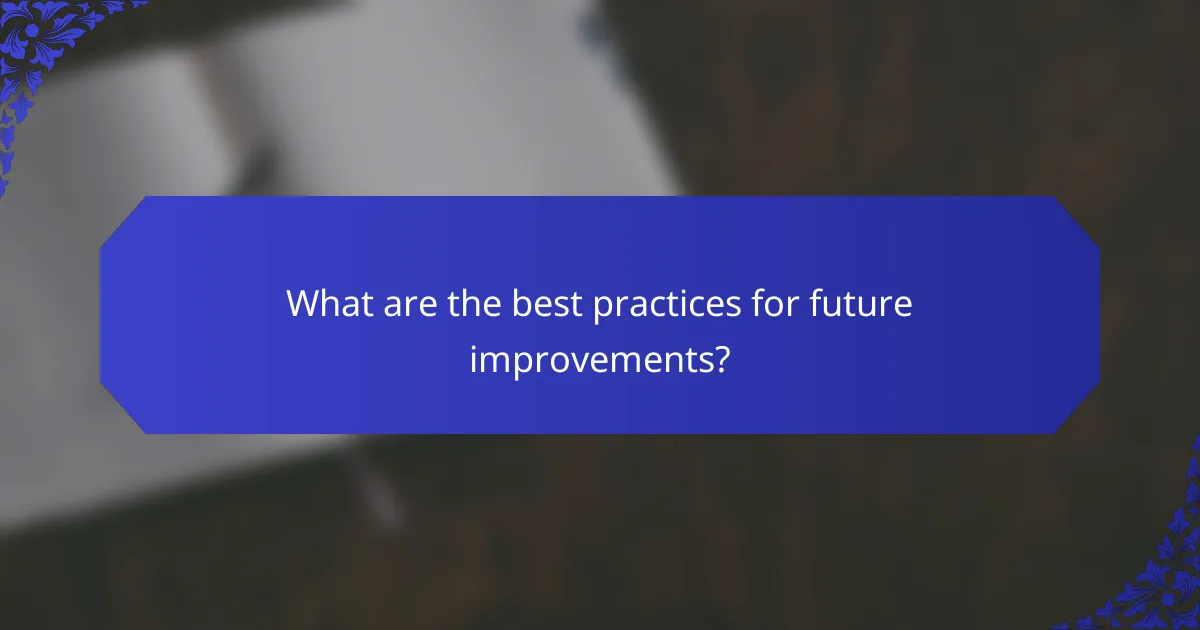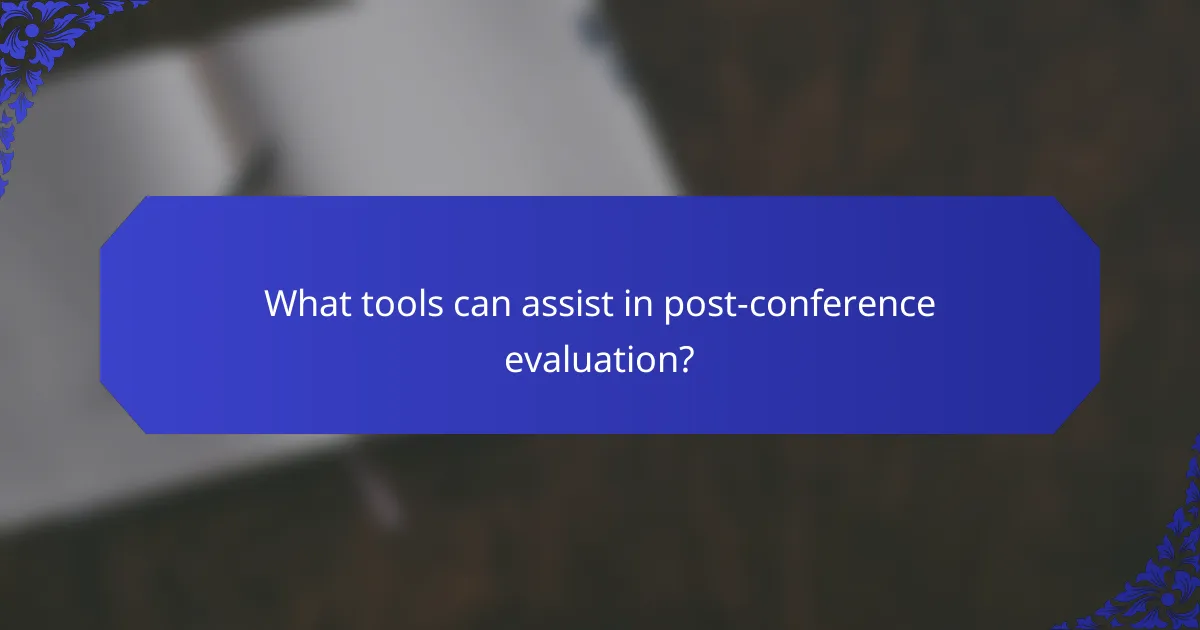Post-conference evaluations are crucial for understanding the effectiveness of the event and gathering valuable insights from attendees. By employing various feedback collection methods, organizers can assess success metrics such as attendee satisfaction and engagement levels, while also identifying areas for future improvements. Analyzing both qualitative and quantitative data provides a comprehensive view of the conference’s impact, guiding enhancements for subsequent events.

How to collect feedback after a conference in the UK?
Collecting feedback after a conference in the UK involves various methods to gather insights from attendees. Effective feedback collection helps assess the event’s success and identify areas for improvement.
Online surveys using SurveyMonkey
Online surveys, particularly through platforms like SurveyMonkey, are a popular way to collect feedback efficiently. They allow attendees to share their thoughts anonymously and can be distributed via email or social media shortly after the event.
To maximize response rates, keep surveys concise, ideally under 10 questions, and include a mix of multiple-choice and open-ended questions. Consider offering a small incentive, such as a discount on future events, to encourage participation.
In-person interviews with attendees
Conducting in-person interviews with attendees can provide deeper insights into their experiences. This method allows for follow-up questions and clarifications, leading to richer feedback.
Choose a diverse group of attendees to interview, ensuring representation from different demographics and interests. Schedule these interviews shortly after the event while the experience is still fresh in their minds.
Feedback forms distributed at the event
Distributing feedback forms during the event is an immediate way to capture attendees’ thoughts while they are engaged. These forms can be paper-based or digital, depending on the venue’s facilities.
Design the forms to be quick and easy to fill out, using a mix of rating scales and brief comment sections. Ensure that attendees know their feedback is valued and will be used to enhance future events.

What success metrics should be evaluated post-conference?
Evaluating success metrics post-conference is essential for understanding the event’s effectiveness and areas for improvement. Key metrics include attendee satisfaction ratings, engagement levels during sessions, and the number of leads generated.
Attendee satisfaction ratings
Attendee satisfaction ratings provide insights into how well the conference met participants’ expectations. Surveys can be distributed immediately after the event to capture feedback on various aspects, such as content quality, speaker effectiveness, and venue facilities.
Consider using a scale from 1 to 5 or 1 to 10 for quantifiable results. Aim for a satisfaction rating of at least 80% to indicate a successful event. Analyze open-ended responses for qualitative insights that can guide future improvements.
Engagement levels during sessions
Engagement levels during sessions reflect how actively participants interacted with the content and speakers. This can be measured through audience polling, Q&A participation, and social media interactions during the event.
High engagement typically indicates that the content resonated with attendees. Look for metrics such as the percentage of attendees who asked questions or participated in discussions, aiming for at least 30% engagement in interactive sessions.
Number of leads generated
The number of leads generated is a critical metric for assessing the conference’s impact on business development. This includes contacts collected through registration, networking events, and exhibitor interactions.
Set specific lead generation goals based on past events or industry standards. A successful conference might aim to generate hundreds of leads, with follow-up strategies in place to convert these into potential clients. Tracking lead quality is equally important, so consider categorizing leads based on their likelihood to convert.

How to analyze feedback effectively?
To analyze feedback effectively, focus on both qualitative and quantitative data to gain a comprehensive understanding of the conference’s impact. This dual approach allows you to identify strengths, weaknesses, and areas for future improvement based on attendee insights.
Qualitative analysis of open-ended responses
Qualitative analysis involves examining open-ended feedback to uncover themes and sentiments expressed by attendees. Start by categorizing responses into common themes, such as content relevance, speaker effectiveness, and logistical issues. This can help you identify specific areas that resonated with participants or aspects that need enhancement.
Utilize tools like coding software or manual tagging to organize comments. Look for recurring phrases or sentiments that indicate overall satisfaction or dissatisfaction. For example, if multiple attendees mention the need for more interactive sessions, this indicates a clear area for improvement in future events.
Quantitative analysis of survey results
Quantitative analysis focuses on numerical data gathered from surveys, providing measurable insights into attendee satisfaction. Use rating scales (e.g., 1 to 5) to quantify responses on various aspects such as session quality, networking opportunities, and overall experience. This allows for easy comparison and trend identification over time.
Calculate key metrics like average ratings and response rates to gauge overall success. For instance, if 70% of respondents rate the conference as excellent, this suggests a strong performance. Additionally, consider benchmarking these results against previous events to assess progress and set future goals.

What are the best practices for future improvements?
To enhance future conferences, it is essential to systematically collect and analyze feedback, set clear success metrics, and identify areas for improvement. These practices ensure that each event builds on the last, leading to greater attendee satisfaction and engagement.
Implementing feedback loops
Feedback loops involve continuously gathering input from attendees before, during, and after the conference. This can be achieved through surveys, suggestion boxes, or interactive sessions where participants can voice their opinions. Regularly reviewing this feedback allows organizers to make real-time adjustments and plan for future events.
For effective feedback loops, consider using digital tools like online survey platforms or mobile apps that facilitate immediate responses. Aim for a response rate of at least 20-30% to ensure the data is representative of the overall attendee experience.
Benchmarking against industry standards
Benchmarking involves comparing your conference’s performance metrics against industry standards or similar events. This practice helps identify strengths and weaknesses, allowing for targeted improvements. Key metrics to consider include attendee satisfaction scores, session attendance rates, and networking opportunities.
To benchmark effectively, research industry reports or case studies from comparable conferences. Use this data to set realistic goals, such as improving attendee satisfaction by a certain percentage or increasing session participation rates. Regularly revisiting these benchmarks can guide ongoing enhancements and ensure your event remains competitive.

How to create a post-conference report?
Creating a post-conference report involves systematically gathering feedback, analyzing success metrics, and outlining areas for future improvement. This report serves as a valuable tool for assessing the event’s effectiveness and guiding future planning efforts.
Summarizing key findings
Summarizing key findings requires collecting feedback from attendees, speakers, and sponsors. Use surveys or interviews to capture insights on various aspects, such as content relevance, speaker effectiveness, and logistical arrangements.
Focus on identifying trends in the feedback, such as common praises or recurring issues. For instance, if multiple attendees highlight the quality of networking opportunities, this can be a strong point to emphasize in future events.
Visualizing data with charts
Visualizing data with charts enhances the clarity of your post-conference report. Use bar graphs or pie charts to represent quantitative data, such as attendee satisfaction ratings or session attendance numbers. This makes it easier for stakeholders to grasp the overall success of the conference at a glance.
Consider using tools like Excel or Google Sheets to create these visualizations. Ensure that each chart is clearly labeled and includes a brief explanation of what the data represents, helping to contextualize the findings for readers.

What tools can assist in post-conference evaluation?
Several tools can facilitate post-conference evaluation by streamlining feedback collection and analyzing success metrics. These tools help organizers gather insights from attendees, assess the event’s impact, and identify areas for improvement.
Google Forms for feedback collection
Google Forms is a versatile tool for collecting feedback after a conference. It allows organizers to create customized surveys that can include various question types, such as multiple-choice, short answer, and rating scales. This flexibility makes it easy to gather specific insights about attendee experiences.
To use Google Forms effectively, design your survey to cover key areas such as session quality, speaker effectiveness, and overall satisfaction. Keep the survey concise, ideally under 10 questions, to encourage higher response rates. You can share the form via email or social media, ensuring it reaches all participants.
Common pitfalls include making surveys too long or complex, which can lead to lower completion rates. To avoid this, consider testing your form with a small group before the conference to refine questions and layout. Additionally, offering a small incentive, like a discount on future events, can boost participation.
